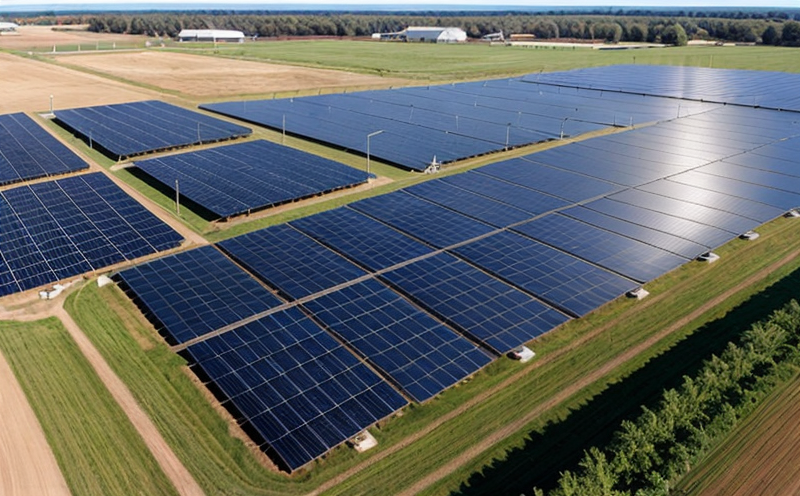IEEE 519 Harmonic Distortion Compliance Testing in Emerging Grids
The IEEE Standard 519-2014 provides guidelines to reduce harmonic and related voltage distortion for systems ranging from utility grids to industrial facilities. In the context of emerging renewable energy technologies, these standards are critical as they ensure harmonized operation among various sources connected to the grid. This service focuses on conducting thorough compliance testing based on IEEE 519-2014 to verify that new and existing devices meet the required harmonic distortion levels.
Emerging grids often face challenges due to the integration of renewable energy systems such as solar photovoltaic (PV) arrays, wind turbines, and energy storage systems. These installations can introduce harmonic distortions into the grid which may lead to operational inefficiencies or even equipment failure if not properly managed. By adhering to IEEE 519 standards during design and implementation phases, stakeholders ensure that their systems are robust against such issues.
The testing process typically involves measuring voltage waveforms at key points in the distribution system under different load conditions. This helps identify any potential sources of harmonic distortion within the connected devices or infrastructure components. Once identified, appropriate corrective measures can be implemented to minimize these distortions thereby enhancing overall grid stability and reliability.
Accurate measurement equipment calibrated according to international standards is essential for reliable results during this type of testing. Our laboratory utilizes advanced instrumentation capable of capturing very fine details in electrical signals which allows us to detect even small deviations from expected performance levels. We also employ specialized software tools that help analyze collected data, providing comprehensive insights into the extent and nature of any issues found.
Compliance with IEEE 519 is crucial not only for meeting regulatory requirements but also for protecting investments in renewable energy projects. Non-compliance could result in penalties from regulatory bodies or even force shutdowns of non-conforming assets until they achieve compliance. Therefore, conducting periodic assessments throughout the lifecycle of a project ensures continuous adherence to best practices and fosters long-term success.
Our comprehensive approach includes not just testing but also consulting services aimed at helping clients understand how specific technologies impact grid stability and what actions need to be taken proactively to address these impacts before they become problematic. By leveraging our expertise in this area, businesses can make informed decisions about their energy strategies while minimizing risks associated with non-compliance.
For instance, we have worked closely with several clients in the solar PV sector where inverters are known contributors to harmonic distortions. Through rigorous testing and analysis, we helped these companies identify areas for improvement and develop solutions that complied fully with IEEE 519 standards. Such proactive measures not only enhance reliability but also contribute positively towards sustainable development goals.
With our deep understanding of both the technical aspects involved as well as the broader implications for business operations, we offer a full suite of services tailored specifically to address IEEE 519 compliance testing in emerging grids. From initial consultation through final reporting and recommendations, every step is designed with your specific needs in mind.
Why It Matters
The importance of ensuring compliance with IEEE Standard 519 cannot be overstated, especially when dealing with the complexities inherent in modern power systems. Harmonic distortions can cause significant problems if left unchecked; they not only affect equipment performance but also contribute to increased energy losses across entire networks.
- Reduces operational costs by minimizing maintenance and repair expenses linked to faulty components.
- Promotes better utilization of existing infrastructure which enhances efficiency without requiring additional capital expenditure.
- Aids in meeting regulatory requirements, thereby avoiding potential fines or sanctions from authorities responsible for enforcing such regulations.
By adhering strictly to IEEE 519 guidelines during design and installation stages, organizations can significantly reduce the risk of encountering these challenges. Furthermore, compliance fosters trust among stakeholders by demonstrating a commitment to quality and integrity which is increasingly important in today’s competitive markets.
In summary, implementing robust testing procedures based on IEEE 519 ensures that all connected devices operate harmoniously within the grid environment. This results in improved performance metrics across multiple dimensions including reliability, efficiency, and sustainability.
Applied Standards
| Standard | Description |
|---|---|
| IEEE 519-2014 | This standard defines recommended practices for control of harmonic currents in electrical power systems. |
| IEC 61000-4-7 | International Electrotechnical Commission specification concerning limits and measurement methods related to voltage fluctuations and flicker. |
| ASTM D5238 | American Society for Testing and Materials standard covering the evaluation of power quality issues associated with harmonic distortions. |
The harmonization provided by these standards ensures compatibility between various sources connected to the grid, promoting a more stable and reliable electrical supply. Our laboratory adheres strictly to all relevant guidelines when performing IEEE 519 compliance testing.
Why Choose This Test
- We offer state-of-the-art instrumentation and software capable of detecting even the slightest deviations from expected performance levels.
- All our staff members are highly qualified professionals with extensive experience in power quality analysis and corrective action planning.
- Our services come complete with detailed reports that provide clear recommendations for addressing any identified issues promptly.
The combination of advanced technical capabilities combined with a thorough understanding of industry best practices makes us the ideal partner for ensuring compliance with IEEE 519 standards. Whether you're designing new systems or maintaining existing ones, our team will help ensure your project meets all necessary requirements while maximizing its potential benefits.





